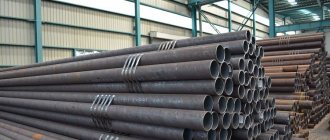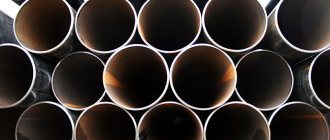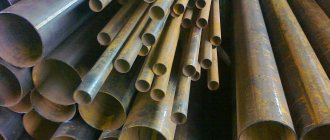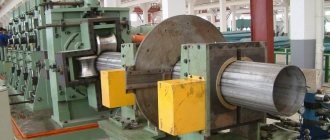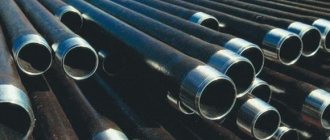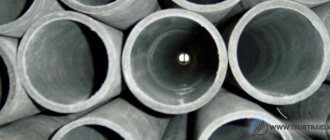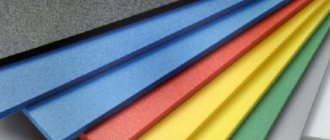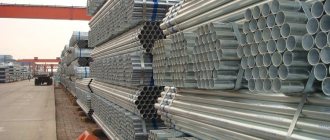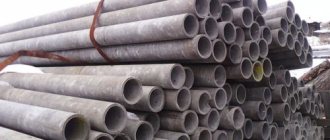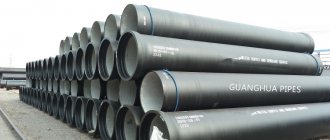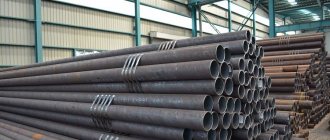Hot-rolled seamless steel pipes are the most common format, successfully used in all economic sectors. These products are known for the greatest reliability, especially for laying communications for various purposes. Most often, hot-deformed seamless steel pipe GOST 8732-78 is used in the construction of monolithic-frame structures, where reliability is paramount under such impressive loads.
Seamless steel pipes have practically no competitors in terms of resistance to high loads
General characteristics and basic information about solid pipes
Seamless hot-rolled pipes of standardization 8732 are produced from steel billets of the main grades:
- 10th, 20th, 35th and 45th standard;
- 35V;
- 40G and 45G;
- 15X and 40X;
- 9X1;
- 20PV;
- 30ХГСА;
- 17G1S,
- 09G2S;
- 10-20DDD.
Hot-deformed seamless pipes are produced in the form of:
- thick-walled products;
- thin-walled products;
- standard products.
These products are in demand and are widely produced by domestic and foreign enterprises. Hot-deformed pipes are made from steel billets and are produced by rolling heated raw materials using specialized factory equipment. Under other conditions, it is impossible to comply with all GOST requirements.
Seamless pipe production technology makes it possible to produce particularly thick-walled products
Good to know! The absence of a longitudinal welding joint is an important visual sign of the assortment of seamless steel pipes GOST 8732-78.
State standardization remains a guarantee of the reliability of seamless pipes, confirming control over key quality indicators. These include:
- absence of flattening, sagging and bends inside the walls;
- high impact resistance of pipes.
At manufacturing enterprises, metal quality control is periodically carried out and the chemical composition of the alloys used is confirmed. At the moment, seamless (w/w) pipe products are produced in two ways:
- cold-deformed seamless pipes;
- seamless hot-deformed steel pipes GOST 8732-78.
Taking into account the wishes of wholesale customers, chamfers and threads are applied to the cut edges of finished products. Sections are also processed - from one end or from both sides. It is worth clarifying all these conditions for product release with the company’s managers before placing an order.
As a rule, a batch of steel pipes GOST 8732-78 is shipped from enterprise warehouses directly to the customer. Warehouses do not always have finished products in the required volume. The cost of pipes varies periodically, depending on steel grades, so all aspects are discussed in advance with the sales departments. Product length varies from 4.5m to 11.9m. It is recommended to check the available assortment with managers.
The ends of the pipes can be untreated or chamfered
Application of thin-walled pipes
A few words about the specifics of products of this type. Since we are talking about technical products, its definition should contain numbers, and not a subjective assessment of belonging to one class or another. So: the range of thin-walled steel pipes includes products with a wall thickness of no more than 1.5 millimeters or if the value of the coefficient determined by the formula
K= Din/Sst., where
Din. is the outer diameter, and S st. – wall thickness, lies in the range of 12.5...40.
A good example of the use of thin-walled metal products includes pneumatic and hydraulic drive systems in the automotive, aviation and shipbuilding industries.
Of course, the above-mentioned area of application for thin-walled steel pipes is far from the only one. They can be found in such industries as:
- construction;
- housing and communal services sector;
- furniture manufacturing;
- boiler houses of energy enterprises.
Architectural elements or decorative items can be made from steel pipes
In everyday life, these products are also not uncommon. But here they are most often used when engineering communications must have moderate strength, sufficient to withstand only low loads. In this case, we are talking primarily about a thin-walled steel pipe for electrical wiring.
What is important to know about standardization of seamless products?
Seamless pipe walls are produced according to GOST only in the specified thickness:
- 2.5, 2.8, 3, 3.5 mm;
- 4, 4.5, 5, 5.5 mm;
- 6, 7, 8, 9 mm;
- 10, 11, 12 mm;
- 14, 16, 17, 18 mm;
- 20, 22, 25, 28 mm;
- 30, 32, 36, 40, 45 mm;
- 50, 56 mm;
- 60, 63 mm,
- 70, 75 mm.
All domestic enterprises producing thick-walled and conventional used pipes are guided by the requirements of several standards:
- GOST 8732-70;
- GOST 8731-74;
- GOST 9567-75;
- GOST 8732-78;
- TU 82-70.
The permissible length of hot-deformed pipes is invariably regulated by the state standard:
- measured and unmeasured length of products (allowed from 4m to 12.5m);
- a multiple of the measured length of products (allowed within unmeasured lengths, plus an allowance for each cut of no more than 5 mm).
Note ! If the pipe length is ordered approximately, then the standards vary in the format of unmeasured length. The preparation time for the required batch of seamless standard pipes varies from two to four weeks, but it all depends on the volume of the order. The minimum batch of used hot-rolled steel pipes according to GOST 8732-78 should be about 3 tons.
According to GOST, the minimum batch of pipes must be at least three tons
The ratio of the wall thickness and the outer diameter of the hot-rolled pipe determines the rating:
- thin-walled used products;
- especially thin-walled;
- thick-walled used products;
- especially thick-walled.
The last two varieties are subjected to heat treatment so that the products receive additional resistance to pressure inside communications and main pipelines.
Seamless pipes are produced in a certain diameter:
- 20, 21.3, 22, 25, 26.9 and 28 mm;
- 30, 31.8, 32, 33, 35 and 38 mm;
- 40, 42, 42.4, 44.5, 45 and 48.mm;
- 50, 51, 54 and 5mm;
- 60, 60.3, 63.5 and 68 mm;
- 70, 73 and 76 mm;
- 82.5, 83, 89 and 95 mm;
- 102, 104, 108 and 114 mm;
- 121, 127, 133, 140 and 146 mm;
- 152, 159, 165 and 168 mm;
- 178, 180 and 194 mm;
- 203, 219, 245, 273 and 299 mm;
- 324, 325, 351, 356 and 377 mm;
- 402, 406, 426, 450, 457, 465 and 480 mm;
- 500, 508 and 530 mm.
Reference! The revised domestic standardizations GOST R 53383-2009, GOST 8732 (78 and 70) offer a new level of quality for seamless products that corresponds to products manufactured according to international standardization.
Today, a range of seamless products continues to be produced according to previously adopted GOST standards - 8732-78 and 8731-74. And in 2010, a national standard for products GOST R 53383-2009 was adopted, regulated by compliance with the requirements of TU 82-70.
According to GOST 8732-70, seamless steel pipes have an impressive weight, which is indicated in the standardization table. This especially applies to thick-walled products. Each grade of heavy metal differs in chemical composition, processing ductility and degree of strength, such as seamless pipes of the “70” or “78” standard. To some extent, this also affects the quality of thin-walled products, but a thick-walled solid pipe is guaranteed to be durable.
Features of cold-formed products
It is worth paying attention to several important points regarding pipe design in order to select the right product for your pipeline.
Steel pipes produced in accordance with the GOST document differ:
- high level of thermal conductivity. This is fraught with some unpleasant moments. For example, if you are using the product to supply hot water in your home, it is best not to install the pipes tightly against the walls, as the outer surface of the product may fog up. And this will lead to dampness on the walls and, as a result, the appearance of fungus or mold;
- good electrical conductivity. Therefore, the cold-deformed part is not used to protect and insulate electrical cables;
- susceptible to liquid freezing. Try to install communications from pipes GOST 8734 74, 75, 78 in conditions more or less close to normal temperatures. If the transported liquid freezes inside the pipe, there is a risk of damage to the surface of the product;
- restriction of segments. For 1 km of communications, with a pipe diameter (according to the 8734 78 standard) of 110 mm, there will be approximately 83-85 joints, and, accordingly, weak points.
Application areas of seamless hot-rolled products
The main feature of seamless steel pipes GOST 8732-78 and 70 is the absence of a welding joint, which is noticeable in welded products. This guarantees the greatest strength and sufficient resistance to external influences, as well as to internal pressure of a liquid or gaseous medium.
Seamless pipe products are the basis for water and gas pipelines for various purposes and locations
The main advantage of seamless cold-deformed steel pipes GOST 8732(78) is a sufficient margin of safety along the entire length. Due to this, they are usually used in environments where other types of pipes do not meet the increased reliability standard. These products can withstand impressive internal pressure, which is why enterprises turn to these products:
- oil and gas industry;
- automotive industry;
- aviation;
- producing gas cylinders;
- heavy engineering;
- chemical industry;
- national economic profile;
- construction companies;
- engaged in laying communications.
Pipes are classified according to the ratio of internal and external diameters:
- small – within 114 mm;
- average diameter - within 114 - 480 mm;
- maximum diameter is 480-2500 mm (like a thick-walled steel pipe GOST 8732-78 or 70).
The widespread use of seamless products is due to their multifunctionality and versatility. They are used:
- for main pipelines and communications to the private sector;
- for small-diameter branches when installing water supply and gas pipelines in country houses and dacha communities;
- in the production of frame-type steel structures in cars and mechanisms for various purposes;
- when producing fragments of metal structures, multi-span ceilings and covered galleries;
- to enhance the strength of technical structures and hangars in industrial and agricultural production;
- for installation of highways and bridges, tubular type lighting poles;
- for foundation piles in construction, etc.
Pipes produced using seamless technology successfully serve as load-bearing and decorative structures in construction
Six Classes of Steel Pipe and Their Use by Industry
In accordance with the requirements of GOST 8732-70 and 78, universal seamless steel pipes are made at specialized enterprises using the hot deformation method. They are made from different grades of metal, which differ slightly in chemical composition and other parameters. The basic requirements are regulated by GOST 8731-74, 70, 78 and TU 82-70. For hot rolling, alloy and carbon metal ingots are used according to GOST:
- 4543-71;
- 1050-88,
- 19281-89.
Solid products of measured and unmeasured length (up to 12.5 m) have different assortments, including thick-walled ones, which are also limited by such parameters as pipe wall thickness. This is the difference between the outer diameter and the inner hole, which is what regulates this parameter according to GOST 8732-78.
Large-diameter seamless pipes can withstand impressive loads, including use as:
- elements of lifting mechanisms;
- piles for foundations for high-rise buildings under conditions of seismic activity;
- elements of heavy-duty transport;
- multi-span beams;
- anti-landslide structures and supports,
- integral structures in the construction of railway bridges;
- pipelines containing harmful reagents and explosive substances;
- hydraulic systems and steam pipelines with high internal pressure.
The based classification includes 6 classes:
1st class – production of products made from steel grades with a carbon composition; these are standard and “gas” products that are used in various conditions. However, it is not regulated by strict requirements. These products are in demand in the construction of light supports and bridges, scaffolding and fencing, irrigation structures and supports for cable laying. They are also suitable for local branching of communications.
Pipes are divided into strength classes, this determines their purpose and the possibility of application in a particular area
2nd class: these pipes are also made of carbon grade steel. They are in demand in pipelines and branching systems for highways for various purposes. If there are no special requirements, then they are suitable for lines with moderate and high pressure. This is the transportation of liquids and gaseous media, chemical reagents. The products are used in the production of furniture with metal frames and legs.
3rd class: this type is well adapted to high internal pressure and the operation of pipelines in difficult climatic conditions. Such products have proven themselves in high-temperature manufacturing, boilers and furnaces, and are also used in scientific testing, nuclear engineering and oil pipelines.
4th class: this is the main equipment for oil and gas fields, as well as steel pipes for main pipelines leading from these fields. They are used when working with high pressure in geological exploration and oil wells.
5th class: these are high-strength products that are in demand in various areas. This includes heavy engineering and installation of high structures in construction. This is the production of masts and frames of ships and lighthouses. This includes the construction of cars, motor transport equipment, lifting and bridge cranes, as well as the installation of supports and towers of any functionality.
6th class : products for supplying liquid to tanks under high pressure. Also, high-strength workpieces are used for pistons and piston pumps, and other fields, including mechanical engineering.
Seamless metal products are chosen for certain types of use in industrial production. They are also distinguished according to another criterion - thin-walled and thick-walled. Other quality indicators of thick-walled and thin-walled pipes, which have their own markings, are also taken into account:
- “A” – standardization of mechanical properties;
- “B” – standardization of the chemical composition of the metal;
- “B” – standardization, including control of the two above steel quality indicators;
- “G” – standardization according to the mechanical properties and chemical composition of the metal, tested on analogue samples;
- “D” - includes all previous indicators plus a hydraulic test for resistance to pressure, which only thick-walled products can withstand.
Pipes are divided into thin-walled and thick-walled, they can have different technical characteristics
TEST METHODS
4.1. For quality control, one sample is taken from each selected pipe.
4.2. Chemical analysis of pipe steel is carried out according to GOST 22536.0-87, GOST 22536.1-88, GOST 22536.2-87, GOST 22536.3-88, GOST 22536.4-88, GOST 22536.5-87, GOST 22536.6-88.
Samples to determine the chemical composition of pipe steel are taken according to GOST 7565-81.
(Changed edition, Amendment No. 1,).
4.3. Inspection of pipes is carried out without the use of magnifying devices.
The condition of the inner surface of pipes is monitored by longitudinally cutting samples or cutting out windows around the perimeter of the pipe.
The depth of defects on the outer surface of pipes is checked by filing or another method or by metallographic method on transverse samples.
The depth of defects on the inner surface of pipes is checked using the metallographic method on transverse samples.
(Changed edition, Amendment No. 1,).
4.4. The outer diameter and ovality are checked with a micrometer in accordance with GOST 6507-78 with an accuracy of 0.01 mm, the inner diameter is checked with a plug in accordance with GOST 14810-69 at both ends of the pipe with go-through and no-go plug gauges in accordance with GOST 14808-69, GOST 14809-69 and GOST 14810-69 or calibrated wire.
The length of the passage part of the plug must be at least 15 mm.
(Changed edition, Amendment No. 1).
4.5. The length of the pipes is controlled with a measuring tape in accordance with GOST 7502-69.
4.6. The curvature of the pipes is controlled using a straight edge according to GOST 8026-75 and a feeler gauge according to TU 2-034-225-87.
(Changed edition, Amendment No. 2).
4.7. The tensile test is carried out according to GOST 10006-73 on a longitudinal (in the form of a piece of pipe with a full cross-section or in the form of a strip) proportional short sample.
4.8. Hydraulic testing is carried out in accordance with GOST 3845-75 with holding pressure for at least 10 s.
Pipe making process
The modern technological process for hot-rolled pipe production is well-established, which makes it possible to obtain durable and multifunctional products from rolled metal blanks. According to GOST 8732-78, products are produced from:
- open hearth rolled ingots;
- prepared pipe blanks;
- forged blanks;
- continuously cast billets.
The production of hot-rolled steel pipes GOST 8732-78 goes through several stages:
- forming a gap in a metal workpiece using a special piercing mill, which consists of a frame for piercing and conical shafts;
- heating steel to 1200°C;
- bringing the product using special equipment to the expected format that complies with GOST.
In accordance with GOST 8732-78 and 8732-70, hot-deformed seamless products are produced in a wide range of assortments. Thick-walled products, with an outer diameter in the range of 25mm - 700mm and wall thickness in the range of 2.5mm - 75mm, are used for various technical and economic needs.
The range of unmeasured length is limited to 4m - 12m, and the measured length assumes sizes up to 12m. Larger products are difficult to transport.
Attention ! All questions regarding the standardization of GOST 8732-70 for seamless steel pipes and the selection of products for various purposes should be compared using tables. Clients usually receive all advice and recommendations from the managers of the issuing enterprise or through the information website.
TECHNICAL REQUIREMENTS
2.1 Pipes must be manufactured in accordance with the requirements of this standard and according to technological regulations approved in the prescribed manner from carbon steel grade 20 with a chemical composition in accordance with GOST 1050-74. The mass fraction of sulfur should not exceed 0.035%.
By agreement between the manufacturer and the consumer, it is possible to manufacture pipes from steel of other grades.
(Changed edition, Amendment No. 1).
2.2. Group A pipes are made from turned and bored blanks. Group B pipes are made from billets without turning or boring.
2.3. Group A pipes are manufactured by heat treatment in a protective atmosphere.
Pipes of group B are subjected to heat treatment in a protective atmosphere only on the finished size.
The tensile strength (sв) of pipes made of steel grade 20 should be no less than 392 N/mm2 (40 kgf/mm2), relative elongation (d5) should be no less than 21%.
At the request of the consumer, pipes are manufactured with a temporary resistance (sv) of 392 - 510 N/mm2 (40 - 52 kgf/mm2).
(Changed edition, Amendment No. 1).
2.4. The outer and inner surfaces of the pipes must be even, smooth, and free from scale, film, dulls, cracks, hairlines, cavities and deep scratches.
There should be no contamination in the pipe channel.
2.5. The following is allowed on the outer surface of the pipes: an oxide film that does not interfere with inspection, individual dents, small marks and scratches, traces of pipe straightening and cleaning with sandpaper or a file with a velvet notch, provided that their size for pipes of group A should not exceed 0.10 mm ;
for pipes of group B - increased manufacturing precision and pipes of normal manufacturing precision with an outer diameter of up to 10 mm should not exceed 0.15 mm, with an outer diameter of more than 10 mm should not exceed 0.20 mm.
2.6. The following are allowed on the inner surface: an oxide film that does not interfere with inspection, local irregularities (minor roughness, faceting and folds with a gentle base), gentle scratches and small scratches, narrowing and widening of the internal channel in the form of rings, provided that their size is for pipes of group B normal manufacturing accuracy does not exceed half of the maximum deviations (plus or minus) along the internal diameter; for pipes with increased manufacturing accuracy and pipes of group A - 0.08 mm.
For group A pipes with dimensions: outer diameter 7.5 mm, inner diameter 1.1 mm; outer diameter 8 mm, inner diameter 1.5 mm; outer diameter 8 mm, inner diameter 2.0 mm; outer diameter 10 mm, inner diameter 3.0 mm; depth of defects should not exceed 0.04 mm.
2.7. The ends of the pipes must be cut at right angles and cleared of burrs.
2.8. Pipes must withstand hydraulic pressure ( P
1) in accordance with the requirements of GOST 3845-75.
In this case, the value of R
is taken equal to 40% of the tensile strength for a given steel grade.
The ability of pipes to withstand hydraulic pressure is ensured by production technology.
The consumer is allowed to carry out hydraulic testing of pipes at a pressure 50% higher than the maximum injection pressure, but not more than the value obtained from the formula.
2.9. (Deleted,
Amendment No. 1 ).
Standards for Thick Walled Products
Thick-walled seamless pipe GOST 8732 is a high-strength product used for the construction of all kinds of metal structures or transportation of gases and liquids under high pressure. Welded products are used less frequently; preference is given to seamless pipes, and steel of different grades is suitable for this.
To increase resistance to corrosion, pipes are coated inside and outside with a protective layer of zinc, chromium or nickel
To prevent the inside of the pipe from rusting (important for supplying liquids of a certain chemical composition), thick-walled products are made from non-ferrous metals or are nickel-plated on the inside. They are used in the chemical industry and for transporting liquids from great depths.
Visually this is almost always noticeable, but there are standards by which thick-walled products are produced - within the range of 6mm - 12.5mm. If the hole inside is small and the wall is impressive, then these are especially thick-walled pipes. They are produced only by hot method.
The quality indicators of thick-walled pipes classify them according to the main standards: “B”, “C”, “D”:
- “B” - standardization of the chemical composition of the metal, including GOST 19281-89, GOST 4543-71, GOST 1050-88 and 8732-70;
- “B” - standardization of thermal indicators;
- “D” - without special regulation, but with internal pressure tests.
GOST 8732-70 also regulates the length of thick-walled pipes - products of unmeasured and measured lengths:
- non-dimensional format from 1.5 m to 11.5 m;
- dimensional format from 4.5m to 9m;
- length, a multiple of the measured length, within 1.5 m - 9 m (with an allowance of 5 mm for each segment).
Thick-walled pipes bend poorly, but they are products of increased strength and resistance to mechanical stress. Their main function is to transport gaseous and liquid media under pressure. But they are also indispensable as frost-resistant building materials; large-format welded products are also suitable for this. These products are subject to the requirements of GOST 8732-78 and TU 14-3-1128-2000. To produce workpieces with thick walls, the following steel grades are usually used:
- 10G2;
- 09G2S (low alloy alloy for welded structures, silicon and carbon up to 1% and 2% manganese).
On a note! Welding of pipes with a seam is carried out with or without preheating. The less carbon in the steel grade, the easier the welding. When welding, the steel does not overheat, does not harden, and the viscosity does not decrease. And the alloy’s resistance to low temperatures makes it possible to effectively use 09G2S products even in the Far North.
At the customer's request, steel pipes GOST 8732-78 and 8732-70 can undergo additional hydraulic pressure tests to ensure their strength. The maximum pressure is about 20 MPa, which is allowed only in thick-walled products.
Finished products are tested not only for strength, but also for compliance with GOST standards for length, weight, wall thickness
Cons of seamless pipes
Despite the large number of advantages, the pipe still has some disadvantages. Of course, they must be taken into account when choosing equipment. So, the disadvantages of steel pipes regulated by GOST No. 8734 74, 75, 78, 81, 87 include:
- susceptibility to corrosion. Such a part has only one vulnerable area in this regard - the welded joint. However, in our time, enough ways have already been invented to eliminate such a disadvantage. This is done using various protective coatings, powder coatings, and also by adding special substances to the alloy, such as, for example, according to the GOST standard number 8733 74;
- heavy weight. This disadvantage implies certain difficulties when transporting equipment and installing it;
- high price. When compared with analogues made from other materials, metal equipment manufactured in compliance with all the requirements of GOST 8734 75 and 78 is quite expensive. This is explained, first of all, by manufacturing costs, because such pipes have a high cost;
- limitation on the length of supplied segments. GOST regulates the length of manufactured pipes;
- high thermal conductivity of products. When installed in residential premises, this may lead to the destruction of the decorative finish of the walls, as well as the danger of getting burned on the hot surface of the pipe.
Since steel pipes are heavy, the cost of using equipment for loading and transportation is inevitable
Seamless products: weight and size
In accordance with the standards, wall thickness determines not only the weight, but also the cost of a regular or thick-walled pipe. Metal, with a small error, cannot be lighter or heavier. Therefore, based on the weight of the pipe using the table, you can determine the length of the product and the wall thickness and vice versa.
Prices for hardware of any denomination do not include the linear meter of pipe, but the amount of metal used and the cost of processing. Of course, no one would think of weighing every pipe. We can confidently say that if the cross-section and wall thickness of the pipe are the same, then the mass of all of them will be the same.
Linear meter figures vary slightly, which includes options:
- metal grade;
- pipe format;
- diameter (the difference between the cross-section and wall thickness).
These parameters determine the so-called “theoretical” weight, noted in the regulatory tables of GOST 8732 for assortment. The weight of the pipes is calculated:
- on a special “Metal Calculator” (this is a special computer program);
- a special formula available at each production and at specialized companies involved in the supply of metal products.
Accuracy of calculation implies the correspondence of the parameters that are entered into the program. The approximate weight of the ordered batch is determined by a theoretical formula, where the “theoretical” weight of the products (in linear meters) is multiplied by the length. This helps determine what transport capacity will be required to transport a batch of workpieces for communications or construction.
Calculating the weight of the pipes required for installation of the system allows you to determine the load-carrying capacity of the equipment for their transportation.
Formula for 1 meter of pipe:
0.02466 S (D - S),
where “D” is the outer diameter in mm, S is the wall thickness of the product in mm, and the metal density is taken according to the standard 7.850 g/cm³.
This standardization involves the production of pipes:
- dimensional format (within the unmeasured length of products);
- undimensional format (4m – 12.5m);
- multiple measured length (within the non-dimensional format with cutting tolerances);
- approximate length (within unmeasured range).
Note! The company, at the request of the customer, is capable of producing products with parameters that go beyond the limits indicated in the tables. For thick-walled products, the format must be specified, including the total mass of the batch. If we are talking about approximate length, then all other parameters must be agreed with the buyer.
Advantages and disadvantages
Let's consider the pros and cons of cold-deformed seamless bends.
The advantages of the product include:
- Higher quality of workmanship in terms of dimensional accuracy and geometry of products in comparison with hot-rolled products.
- Greater strength, allowing the use of pipes in complex and critical systems.
- The ability to process products with chrome plating and galvanizing, which improves their anti-corrosion properties.
The disadvantage is the high price compared to hot-rolled products.
